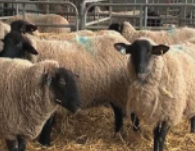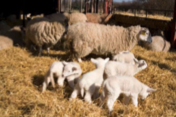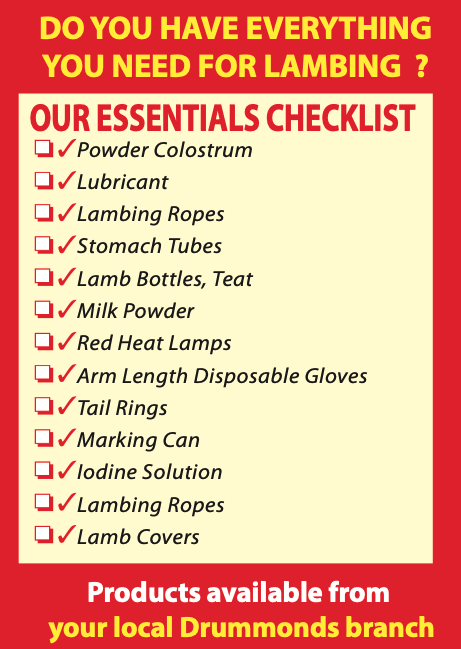Feeding ewes on a high plane of nutrition in the last 6 weeks of pregnancy will aid the development of healthy, vigorous lambs. There is a massive focus on feeding levels during late pregnancy, but a similar level of focus needs to apply to driving milk production after lambing.  Colostrum or ‘beestings’ is the first milk that the ewe produces for about 24 hours after lambing; it is the engine that keeps young lambs going, it provides newborn lambs with nutrition but it also contains antibodies that are crucial for the lambs immunity to disease. Every lamb should receive 50 ml/kg birth weight of colostrum. The ewes’ nutrient demands to support colostrum and milk production increase rapidly after lambing. Feeding a high specification ration before and after lambing will drive udder development and milk production.
Colostrum or ‘beestings’ is the first milk that the ewe produces for about 24 hours after lambing; it is the engine that keeps young lambs going, it provides newborn lambs with nutrition but it also contains antibodies that are crucial for the lambs immunity to disease. Every lamb should receive 50 ml/kg birth weight of colostrum. The ewes’ nutrient demands to support colostrum and milk production increase rapidly after lambing. Feeding a high specification ration before and after lambing will drive udder development and milk production.
Milk yield peaks at 3-4 weeks after lambing and nutrient demands to support this milk production increase rapidly. Ewes will usually be out on grass at this stage and since the nutrient requirements for ewes suckling multiple lambs can’t be met by grass alone, a high specification concentrate should be offered to ewes.
 A 75kg ewe rearing twins will increase her daily energy require- ments by 60% and daily protein requirements by 44% at peak milk production. Good lush spring grass cannot solely support this demand without the ewe ‘milking off her back’. The simplest and easiest solution is to continue feeding the same concentrate used in late pregnancy, at least for the first four weeks of lactation. The lamb is entirely dependent on milk for all its nutrients during this time, so aim for a high energy feed, with 16-18% crude protein for those ewes out on grass. A 75kg ewe with twins typically needs up to 1.1kg/day of supplementary feed. Where flocks only have access to poor quality grassland, or early lambing ewes are heavily reliant on silage or hay until grass growth takes off, up to 1.6kg/day will be needed, especially for bigger ewes.
A 75kg ewe rearing twins will increase her daily energy require- ments by 60% and daily protein requirements by 44% at peak milk production. Good lush spring grass cannot solely support this demand without the ewe ‘milking off her back’. The simplest and easiest solution is to continue feeding the same concentrate used in late pregnancy, at least for the first four weeks of lactation. The lamb is entirely dependent on milk for all its nutrients during this time, so aim for a high energy feed, with 16-18% crude protein for those ewes out on grass. A 75kg ewe with twins typically needs up to 1.1kg/day of supplementary feed. Where flocks only have access to poor quality grassland, or early lambing ewes are heavily reliant on silage or hay until grass growth takes off, up to 1.6kg/day will be needed, especially for bigger ewes.
Research has shown lambs born to ewes that had been offered a soya bean-based concentrate were 1.2kg heavier at weaning than lambs born to ewes offered concentrate that contained by-products (rapeseed meal, maize distillers) as the protein source. This is largely down to the quantity and quality of milk available to the lamb in its’ early stages. It is always worth checking your feed label to make sure you are getting value for your money.
SUPREME EWE 18% & 20%
Supreme ewe 18% is our top feed for ewes pre and post lambing. Available in 18% and 20%, these rations contain only top quality energy, protein and fibre sources coupled with a generous inclusion of soyabean meal which will drive quality colostrum and milk yields. Both rations include a top spec sheep mineral and CAL MAG to help prevent grass tetany.
DRUMMONDS EWE NUT – 18%, 19% & 20% OPTIONS
The Drummonds nut range is high in energy and protein, coming from a high inclusion of quality maize, barley and soyabean sources. These nuts have been formulated using highly digestible fibre sources to help prevent any pre-lambing upsets. CAL MAG is included to reduce grass tetany when ewes go to grass after lambing.


